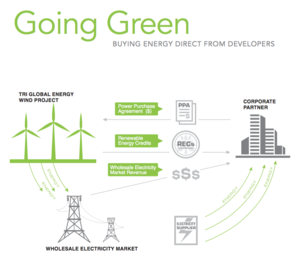
As costs have declined and new contracting options have emerged, renewable energy purchasing has become less of a risk for businesses. Through aggregation and virtual power purchase agreements (VPPAs), customers can enjoy new flexibility when procuring utility-scale renewable energy.
The cost of utility-scale solar power fell nearly 30% in 2017 alone, and has decreased nearly 80% since 2010, according to the National Renewable Energy Laboratory (NREL). Similarly, the International Renewable Energy Agency (IRENA) has reported that costs for on-shore wind power have fallen 45% since 2010. Plummeting renewable generation costs have made utility-scale renewable energy more competitive—and in many cases less expensive than electricity generated from nuclear, coal, and natural gas resources.
Until very recently, however, the favorable economics behind utility-scale renewables had only been available to organizations that use 50,000 MWh annually and can tolerate 15- or 20-year commitments. The companies that have made utility-scale renewable energy purchases over the past five years, for example, is limited to about 50 of the Fortune 500.
We expect that dynamic to change.

